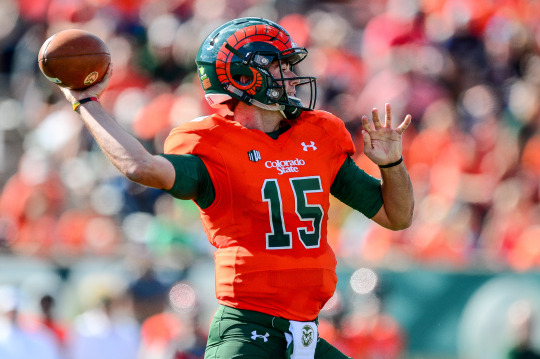#colorado state
Text
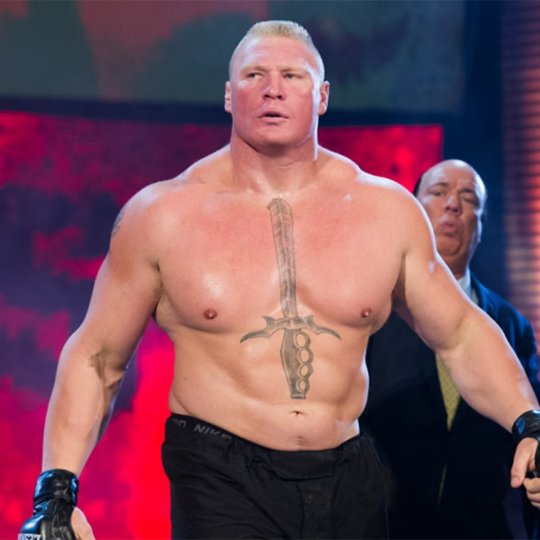

Nothing but respect for Brock Lesnar’s genes. They are unstoppable.
She is literally breaking sports records.
When the aliens invade, she will inevitably be the person we call.
276 notes
·
View notes
Text
For anyone who lives in Colorado and doesn’t want to pay an annual tax on each you own.

This is the bitch that wants to tax your pets

And this is her contact information:

Tell her to resign and fuck off to Hell
#colorado#Regina English#taxes#pets#pet tax#alaskan malamute#siberian husky#cats#dogs#german shepherd#calico#government#state government#colorado state#Colorado government#bullshit#fuck the government#democratic party#republican#gop#contact your representatives
3 notes
·
View notes
Text
Interview with Two Youth Climate Activists.

Do you ever feel paralyzed by climate anxiety? Want to help the planet, but not sure how to go about it? I can assure you, you are not alone.
According to Yale, as of July 2023, 7% of the U.S. population was experiencing diagnosable “psychological distress” as a result of the climate crisis, with higher rates of anxiety attributable to people who identify as Hispanic/Latino or Gen Z/Millennial.
Which is why I was so excited when I first heard about Denver Public Schools Students for Climate Action (DPSS4CA). This student-led organization has turned despair into action by lobbying school board members, city council members, and Colorado state legislators for achievable climate policy. And you know what? It’s working.
Denver Public Schools is now one of only six school districts in the country with a climate action plan. The plan is a robust, 114-page document with specific goals tied to three “North Star[s]”: environmental protection, economic prosperity, and social development. In it, the district commits, among other things, to “[r]educe overall greenhouse gas emissions by at least 90% by 2050 (from a 2010 baseline).” Can you imagine what would happen if other school districts—and industries, and governments—did the same?
Read the full Interview with the Youth Climate Activists.
#climate change#climate axiety#climate action plan.#Denver Public Schools#environmental protection#Colorado state#climate policy#earth day#climate activists#ciimate activism#interviews
0 notes
Text
"Peek around the Corner" suggests PAC-2 expansion may be coming soon.

So for those living under a rock for the last two years, Greg Flugar's You tube channel "Peek Around the Corner" is the best source for realignment discussions today. He broke the story on USC and UCLA to the Big Ten and has been right on almost every realignment move since then.
I have tracked and written about sport conference realignment since the last days of the Southwest Conference and I can tell you his run over the last 2 years is amazing. Really unprecedented and unlikely to ever be matched again. No one else has ever figured out what positions you should talk to get the right information on realignment. Flugar's figured it out and built a network of those guys. What he is doing is next level.
He is now talking about Pac2 expansion stories being imminent, although no new school is currently committed to join yet.
https://www.youtube.com/watch?v=LZZFZ37Kz6g&t=1s
I would encourage Cougar and Beaver fans to check out his report. (Warning, he babbles on about other crap for the first 52 minutes.)
I have been advocating the PAC2 build a conference for quite a while. It now seems like we have a pretty good idea of the plan they chose. It is a little ham-fisted and leaves a ton of available meat uneaten (could be A LOT richer), but when I look at it I see a solid plan that could come together very quickly that a risk-averse leadership would put together.
So lets get started talking about it.
The plan
Buy out the 6 MWC schools with the greatest current media valuations using the PAC treasure trove: Boise State, Air Force Academy, San Diego State, Colorado State, Fresno State, and UNLV. All 6 schools are likely willing co-conspirators as their media payouts will go up and might actually double and they don't have to do a thing.
That immediately gets the conference to 8 schools and solves their conference problems.
Follow that by a raid of specifically the Texas schools (UTSA, N. Texas, and Rice) in the AAC as well as Tulane, Memphis, and Navy. These schools would move to a better home for the two revenue sports and would also likely see raises.
I think it is quite viable. Props to the PAC 2.
Valuation, the engine that makes this possible.
What is the value of the new Pac?
Well. I think we can pretty much guess at it. The PAC1-12-2's hired media evaluators advised the conference that "FAIR MARKET VALUE" of the PAC 12-2 was about $34M per school. Then the conference asked ESPN for $50M each --- pissing off ESPN and leading the "sports leader" to lowball the conference throughout the rest of the negotiation and even pull out of a last-minute offer when Colorado left.
Apple lowballed the PAC because for most of the negotiation period, the were no serious linear providers competing. Many Pac schools were looking at $25M per school as an amount they would tolerate to stay. Apple was going to guarantee something like $23M per school, so I think logically you can say that $27-34M was the general fair market valuation of the PAC-12-2 schools.
Now 6 of those schools are making $32M or more in their new conference homes.
Now obviously the 2 schools no one wanted in the power conferences were WSU and OSU. So you'd have to expect their valuation to be something between the best conference in the non-power ranks --- the AAC (~$9-10M) --- and maybe $25M.
Neither school has really built the kind of basketball support they should have and their football attendance averages were among the worst in the PAC, so pressed I would suspect OSU may be valued at about $20M and WSU at around $13M.
Now let's talk about the MWC. It is a 10/11 conference that is paid on the non-power conference scale. If memory serves they make about $6.5M per school, so the media money pool is about $70M.
The MWC is generally 3 layers of mediocrity although the MWC has a media king --- Boise State. BSU is good in football/solid in BB and has a national fanbase due to their stellar play 10-20 years ago capturing a generation of nationwide fans.
In the first tier of mediocrity, you have schools with definite TV value. After Boise State, you have #2 San Diego State (good FB, great BB in a top 30 DMA), #3 Colorado State (solid football/BB in a top 20 DMA), #4 Fresno State (good FB with great support, mediocre basketball in a forgettable DMA), and #5 Air Force (decent FB, very, very strong national brand).
Arguably, UNLV, Utah State, New Mexico, and Nevada are the next tier. Mediocre football schools with solid basketball programs which are pretty much in a down period across the board. UNLV is liked more than it should be by media companies who still remember the Jerry Tarkanian years but their fan support just sucks.
Then you have the bottom tier. Wyoming is OK in the revenue sports but their fan support is tiny and they are the conference's 2nd team in the Denver DMA. San Jose State has a strong media market but they have some of the weakest programs in the MWC. Their fan support is not valued highly. Hawaii is a football-only member of the MWC and is undergoing a very painful stadium problem that will likely leave a far weaker program than what existed before.
I am not going to go into great detail with this. Let's start at the $70M. Now the value of the MWC schools is discounted because like the Pac-12, they lack markets and footprint population. There is a low ceiling there.
Let's say that the top 5 are collectively worth $40M of your $70M, or basically $8M each. The next tier of 4 may be currently valued at $20M or $5M each. Finally the last 2.5 schools combine to generate the last $10 M, so they maybe are worth $2-4M each to the networks.
I think these premises are reasonable enough.
Now the implications of Flugar's report is that the initial gambit for the new Pac is to add the MWC's top 5 plus UNLV. Now Assuming the networks overpay for UNLV by a million --- reasonable premise --- you are looking at adding their $46M valuation to the Pac-2's $33M.
Now in general, the PAC-2's value is obviously going to be lessened much more by playing Boise State instead of Washington, but the MWC 6 would be enhanced a little by playing Oregon State rather than Wyoming.
We are just working for a quick and dirty breakdown so we are just going to drop the total valuation of $79M to $76M for the initial 8 schools, or roughly $9.5M per school.
Now this is where it gets interesting. Assuming that ballpark is about right, that puts the new Pac essentially on a financial par with the ACC. This means that considering the PAC is no longer a financial issue. It is about "Which conference would house my revenue sports better, the AAC or the PAC?"
The answer is the PAC.
Flugar had suggested that Navy and Tulane were working in unison for some reason as the next most likely to join. Navy I get. That puts Navy and Air Force in the same conference… something they have wanted for a long time, but have been unable to convince Colorado State to move with Air Force to the AAC.
Tulane…. Hmmm… I don't see the specific connection to Navy, but I think I get why they might be ahead of Memphis and the Texas 3. Tulane profits recruiting-wise from being in a conference with access to the 3 largest DMAs in Texas. Tulane has been good in football recently. Tulane might be creeping out the door to try and pull that foursome with them and guarantee Tulane has a slot in the new PAC. That may have been guaranteed to them if they lead.
So then you have 4 central schools --- UTSA, Rice, Memphis, and North Texas which have apparently been given a pitch from the PAC-2 and are likely cautiously listening to see how the PAC8 are valued.
Now I want to be clear, if the PAC 8 values out at peer status, it is HIGHLY likely those 4 schools will move west. Now if this occurs, the new Pac will be able to do something the old PAC with it's academic snobbiness could not --- they will have paired Texas media markets with the markets of the West.
This is something that a lot of media folk had been telling the PAC would save them, but the PAC never did it. It is opening up 11 AM Eastern games. It is making the PAC directly relevant in 3 time zones and tangentially relevant all across the US.
In simple terms, adding Texas gives people on the West Coast a reason to watch Texas Football and people in Texas a reason to watch West Coast football.
I am pretty sure that will push up the per team payouts to $12-14M, which makes it worthwhile to everyone.
So is this your new PAC-14?
What would this cost OSU and WSU?
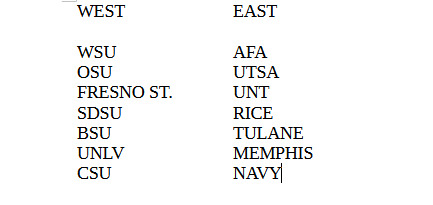
It is all laid out here.
It would seem like it is going to cost $67.5M for 6 MWC schools assuming each school pays their personal $5M+ exit fee, which should be doable given their likely raises in media payouts.
And this may end up essentially costing the PAC 2 …. possibly as little as $24.5M each for WSU and OSU.
$24.5M each? Why so cheap?
The PAC 2 was already on the hook to the MWC for $18M for scheduling alliances. It is possible that if they might not owe that if they add the 6. I don't know... and really when you are sitting on $222M in PAC money, the difference between $49M and $67M to have a good conference home is not that significant.
Should WSU and OSU pursue this?
Yes. Absolutely.
But wait!!! Now, is this worth pursuing with ACC membership possibly becoming available? Well, Flugar says that OSU and WSU are structuring this so if that if an ACC offer comes in they can just bail on the new PAC.
That sounds crazy that teams joining them would be OK with that, but if you peel back the onion it makes sense.
OSU and WSU are using their PAC windfall money to buy the best programs out of the MWC and drop them into a more lucrative home. Regardless of whether the PAC 2 are there or not, the new PAC is still going to pay those schools 50% to roughly double their current annual tv rate.
The central schools would likely reach similar conclusions. The American is kind of a haphazardly slapped-together conference, much like the CUSA that they raided was. This PAC is a much stronger home for their revenue sports even without OSU and WSU.
Will the pac2 be part of a western ACC division?
My gut is screaming no, but a lot of media people are saying "maybe" including now Flugar, a real realignment follower with strong ties. who mentioned it as a possibility. I am not going to lie. I hate that I even have to discuss it as a possibility.
The ACC has continuously snubbed West Virginia, a similar academic school with much, much more valuable program than either WSU or OSU and a much larger fan base in both revenue sports.
Is it possible that an ACC could decide after being gutted and told by ESPN that their payouts are going down say $5-20M per school, that they might decide, "Hey, you know what would make this even better? How about a fat bill for annual trips to the Pacific Northwest in all sports?"
I think WSU and OSU are wise not to count on that. If it shows up, you are building exit clauses. That's probably the right level of consideration for it.
Build a conference that works for you and don't look back. The difference in pay between what this conference would pay you and what a gutted ACC on ESPN's back side might get is a wash and the travel is much better here.
Is this a good plan?
Yes. They have extracted a very, very manageable deal out of MWC commissioner Naverez.
Are there things I would do differently?
Yes. A lot of them, but this is an EXCELLENT frame.
I hate Boise State as a potential member because they are a horrible conference mate. But..... The Leadership at the PAC 2 has done a terrific job planning this out on the MWC side and has left Boise State where they kind of have to go along with the terms and they won't have an American with equal payouts to play off for a better deal. It kind of makes them behave like a decent, honorable conference mate.
SDSU and CSU are worth spending the money to acquire.
Air Force is also worth buying out of the MWC. Think about how many Americans have served in the Air Force or have a family member in the Air Force. That is a huge fan base. And there is every reason to expect if you get Air Force you also get Navy which is also a huge fan base and that you might end up getting Army football in a few years, completing Mike Aresco's long desired trifecta.
It's Fresno State and UNLV where I have problems with this plan. I would argue for Hawaii and UNM instead, even though they are horrible football values today. I think they would cost the PAC 8 stage about $6M in total valuation putting your totals in the $8.5M range. would that skunk your ability to add AAC teams? I don't think so.
Why? Because I firmly believe that within 5 years Notre Dame will carry Stanford into the Big Ten. When that happens Cal will be the only ACC school west of Dallas. If you handle this right you could easily have the perfect home to absorb Cal. Cal would rather be in a home with Hawaii and UNM --- two state flagship schools that do research than Fresno State and UNLV.
Plus I think UNM projects FAR, FAR better in this 14-team layout than UNLV. I can see UNM leveraging Texas recruiting and dominating in basketball and becoming an annual bowl team in football. I am talking about having success like they have never had before because they have NEVER had a good conference footprint. Having that kind of BB program --- paired with Memphis in an eastern division --- interacting with the three Texas schools could jump-start basketball at your Texas schools. UNM makes sense.
I see pretty much the same UNLV as exists today, but weaker and weaker in football as they lose football ticket revenue to the Raiders. They are already an afterthought in basketball. I think that is just a bad add, but I recognize the networks would push them and pay a relative premium for them and that may be something OSU and WSU believe they would need to get the AAC schools.
Fresno State would be an admitted competitive loss. They support football like champions and I hate pooping on their addition, but you KNOW Cal is not going to want to be in the same conference as Fresno State. And their media valuation cannot be that high.
Hawaii on the other hand is a super liberal state (cal friendly), they do a ton of research, they HAD a pretty decent football fanbase, draw acceptably in basketball, and they are a gateway to recruits and students from Australia, New Zealand, and Asia. That is money in your coffers. More to the point, that is all Cal-friendly stuff. Trips to Hawaii are a recruiting tool. Given the footprint of the Western division, the costs would be bearable. A lot of Hawaiian and Samoan talent fed the old Pac-12 schools and now could be easily harvested by OSU and WSU at the cost of their "big brother" universities... Hawaii is like UNM... a forgettable school in a weak conference, an immensely strangely valuable school in a stronger conference. And specifically could help OSU and WSU in recruiting.
With money to recruit California, New Zealand, and Australia, Hawaii would be above average in football in this conference. Probably Fresno State level on the field.
But I would understand if the PAC 2 saw Hawaii as a "future add" candidate with their current stadium issues. (Build a 40K stadium state of Hawaii!). There are a lot of options with those last two spots that you can pull off spending less and getting better results.
So I would argue in general to build "pro-Cal". I anticipate when Stanford and Notre Dame bail on Cal, Cal will be working hard to get into the Big 12 but will probably have a vote problem. A Cal-friendly Pac would land them, I think, and that would push the new pac into a higher level.
I am going to stop here, but there are other things that could be done to add millions to their conference coffers annually, but great start Pac 2!!!
#osu beavers#washington state#new mexico lobos#uh manoa#colorado state#memphis#tulane university#utsa roadrunners
0 notes
Text
#basketball#march madness#colorado#colorado state#wyoming#college basketball#womens college basketball#ncaam#ncaaw#CU buffs#CSU Rams#Wyoming Cowgirls#UNC Bears
0 notes
Text
#Colorado State#Jay norvell#Mountain West#NCAAF#Pac12#Tory Horton#college football#ncaa#ncaa football
0 notes
Text
Deion Sanders’ Colorado Buffaloes Undefeated After Win Over Colorado State in Double OT
Colorado Buffaloes scored a victory over Colorado State Saturday evening. If you went to bed, you missed out! For us who stayed awake until the early AM to watch this showdown, we are the LUCKY ONES.
Shedeur Sanders threw a TD pass to Michael Harrison in the second OT after leading the drive to tie the game with 36 seconds remaining in the fourth quarter, and No. 18 Colorado rallied to beat…
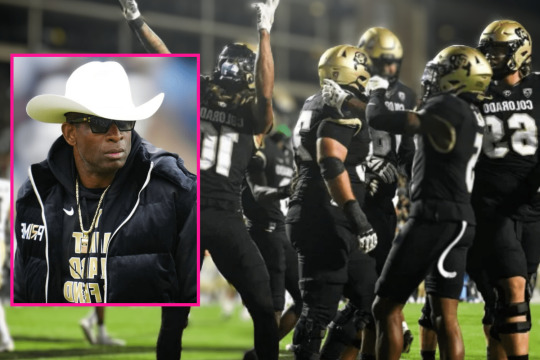
View On WordPress
0 notes
Text
tfw it’s the other coach backing up his smack talk

0 notes
Text
5 Serene Retirement Houses in Colorado: Embrace Tranquility in Your Golden Years
As we approach retirement, finding the perfect place to settle down and enjoy our well-deserved golden years becomes a top priority. Colorado, with its stunning natural beauty and thriving communities, offers an abundance of retirement houses that cater to various preferences.
In this article, we’ll explore five exceptional retirement houses in Colorado that provide the perfect blend of comfort,…
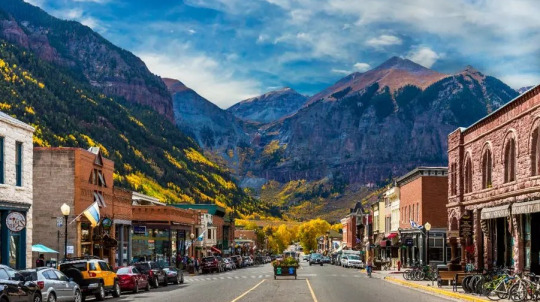
View On WordPress
#Colorado#Colorado state#life after work#retiree#retirees#retirement#retirement community#retirement plan#retirement planning#the golden years#us
1 note
·
View note
Text

"In a stunning and unprecedented decision, the Colorado Supreme Court removed former President Donald Trump from the state’s 2024 ballot, ruling that he isn’t an eligible presidential candidate because of the 14th Amendment’s “insurrectionist ban.”"
source 1
source 2
source 3
#destiel meme news#destiel meme#news#united states#us news#us politics#donald trump#fuck trump#2024 elections#biden harris 2024#elections#2024 presidential race#OF FUCK YEAH#YEAAAAAAAH#BIG WIN BIG WIN FOR DEMOCRACY#colorado#thank you Colorado
3K notes
·
View notes
Text



114th Border War Game
Wyoming Cowboys at Colorado State Rams
Saturday, November 12, 2022
Canvas Stadium, Colorado Springs, CO
#University of Wyoming#Wyoming#UW#Wyoming Cowboys#Cowboys#Pokes#Colorado State University#Colorado State#CSU#Colorado State Rams#Rams#Mountain West Conference#Mountain West#MW#NCAA#Football
0 notes
Text
"Namibia is the driest country in Sub-Saharan Africa, and home to two of the world’s most ancient deserts, the Kalahari and the Namib. The capital, Windhoek, is sandwiched between them, 400 miles away from the nearest perennial river and more than 300 miles away from the coast. Water is in short supply.
It’s hard to imagine life thriving in Windhoek, yet 477,000 people call it home, and 99 per cent of them have access to drinking water thanks to technology pioneered 55 years ago on the outskirts of the city. Now, some of the world’s biggest cities are embracing this technology as they adapt to the harshest impacts of climate change. But Namibia leads the way.
How did this come about? In the 1950s, Windhoek’s natural resources struggled to cope with a rapidly growing population, and severe water shortages gripped the city. But disaster forced innovation, and in 1968 the Goreangab Water Reclamation Plant in Windhoek became the first place in the world to produce drinking water directly from sewage, a process known as direct potable reuse (DPR).
That may sound revolting, but it’s completely safe. Dr Lucas van Vuuren, who was among those who pioneered Windhoek’s reclamation system, once said that “water should not be judged by its history, but by its quality”. And DPR ensures quality.
This is done using a continuous multi-barrier treatment devised in Windhoek during eight years of pilot studies in the 1960s. This process – which has been upgraded four times since 1968 – eliminates pollutants and safeguards against pathogens by harnessing bacteria to digest the human waste and remove it from the water. This partly mimics what happens when water is recycled in nature, but Windhoek does it all in under 24 hours...
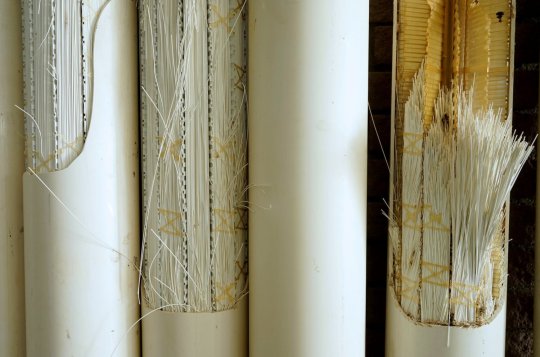
Pictured: These ultrafiltration membranes help to remove bacteria, viruses and pathogens. Image: Margaret Courtney-Clarke
“We know that we have antibiotics in the water, preservatives from cosmetics, anti-corrosion prevention chemicals from the dishwasher,” Honer explains. “We find them and we remove them.”
Honer adds that online instruments monitor the water continuously, and staff ensure that only drinking water that meets World Health Organisation (WHO) guidelines is sent to homes. If any inconsistencies are detected, the plant goes into recycle mode and distribution is halted until correct values are restored.
“The most important rule is, and was, and always will be ‘safety first’,” says Honer. The facility has never been linked to an outbreak of waterborne disease, and now produces up to 5.5m gallons of drinking water every day – up to 35 per cent of the city’s consumption.
Namibians couldn’t survive without it, and as water shortages grip the planet, Windhoek’s insights and experience are more important than ever.
Interest from superpowers across the globe
In recent years, delegations from the US, France, Germany, India, Australia, Singapore, and the United Arab Emirates have visited Windhoek seeking solutions to water shortages in their own countries.
Megadrought conditions have gripped the US since 2001, and the Colorado River – which provides 40 million people with drinking water – has been running at just 50 per cent of its traditional flow. As a result, several states including Texas, California, Arizona and Colorado are beginning to embrace DPR.
Troy Walker is a water reuse practice leader at Hazen and Sawyer, an environmental engineering firm helping Arizona to develop its DPR regulations. He visited Windhoek last year. “It was about being able to see the success of their system, and then looking at some of the technical details and how that might look in a US facility or an Australian facility,” he said. “[Windhoek] has helped drive a lot of discussion in industry. [Innovation] doesn’t all have to come out of California or Texas.”

Pictured: The internal pipes and workings of Namibia's DPR plant. As water becomes scarcer in some parts, countries are looking to DPR for solutions. Image: Margaret Courtney-Clarke
Namibia has also helped overcome the biggest obstacle to DPR – public acceptance. Disgust is a powerful emotion, and sensationalist ‘toilet to tap’ headlines have dismantled support for water reuse projects in the past. Unfortunately, DPR’s biggest strength is also its biggest weakness, as the speed at which water can re-enter the system makes it especially vulnerable to prejudice, causing regulators to hesitate. “Technology has never been the reason why these projects don’t get built – it’s always public or political opposition,” says Patsy Tennyson, vice president of Katz and Associates, an American firm that specialises in public outreach and communications.
That’s why just a handful of facilities worldwide are currently doing DPR, with Windhoek standing alongside smaller schemes in the Philippines, South Africa and a hybrid facility in Big Spring, Texas. But that’s all changing. Drought and increased water scarcity worldwide are forcing us to change the way we think about water.
Now, the US is ready to take the plunge, and in 2025, El Paso Water will begin operating the first ‘direct to distribution’ DPR facility in North America, turning up to 10m gallons of wasterwater per day into purified drinking water – twice as much as Windhoek. San Diego, Los Angeles, California, as well as Phoenix, Arizona are also exploring the technology."
Of course, DPR is not a silver bullet in the fight against climate change. It cannot create water out of thin air, and it will not facilitate endless growth. But it does help cities become more climate resilient by reducing their reliance on natural sources, such as the Colorado River.
As other nations follow in Namibia’s footsteps, Windhoek may no longer take the lead after almost six decades in front.
“But Windhoek was the first,” Honer reminds me. “No one can take that away.”"
-via Positive.News, August 30, 2023
#namibia#africa#desert#water shortage#water conservation#dpr#potable water#water recycling#clean water#drought#united states#colorado river#science and technology#sanitation#good news#hope
2K notes
·
View notes
Text


We did tourist things.
#photographers on tumblr#Hoover Dam#Lake Mead#Arizona / Nevada state line#Colorado River#tourists#phone photo
1K notes
·
View notes
